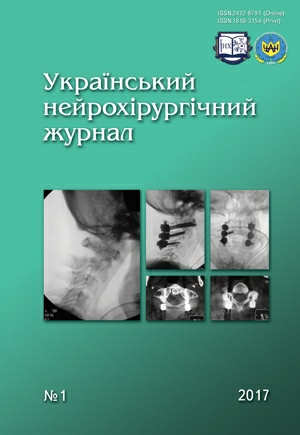Surgical treatment of C2 hangman’s fracture
DOI:
https://doi.org/10.25305/unj.96108Keywords:
C2 fracture, cervical spine injury, stabilizationAbstract
Purpose. To evaluate the treatment efficacy in patients with C2 hangman’s fracture.
Materials and methods. During the period from 2012 to2015 in the Regional Neurosurgical Department 5 patients with hangman’s fracture of C2 vertebra underwent surgery (3 males and 2 females). Fracture type II was diagnosed in 2 patients, IIа type — in 2 persons, type III — in 1 patient. All patients had such clinical symptoms as cervicalgia, deteriorating on the movement. Four patients underwent transpedicular stabilization of C1—C2–C3 with skeletezation of lateral mass, one patient had a combination of posterior instrumentation with anterior plating C2–C3 by Medtronic Atlantis. Posterior stabilization was achieved by Medronic Vertex system.
Results. During the operation, all patients achieved fusion of an injured segement. The patients were activated the same or next day after surgery. The volume of rotational motion in craniovertebral junction was limited to 180є—200є, but this did not worse the quality of life of the (VAS 8.9 and 2.3, NDI 80.6—19.6 % before and within the investigation, respectively). CT control was performed in 6 months. Fracture healing and the complete stability of the damaged segment were achieved in 6 months.
Conclusions. Surgical treatment of C2 hangman’s fractures by posterior transpedicular/transarticular or anterior-posterior stabilization is a high-effective method for rapid restoration of ordinary physically active social life.
References
1. Greenberg M. Handbook of Neurosurgery. Tampa, Fla.: Greenberg Graphics; 2010.
2. Midov MZ, Dreval’ ON, Dzukaev DN, Kuznetsov AV, Zavarukhin VB. [Diagnosis and treatment of complicated subaxial injury]. Zh Vopr Neirokhir Im NN Burdenko. 2010;3:48-54. Russian. [PubMed]
3. Edwards CC, Levine AM. The management of traumatic spondylolisthesis of the axis. J Bone Joint Surg Am. 1985;67(2):217-26. [PubMed]
4. Assaghir Y. Burst C2 fractures combined with traumatic spondylolisthesis: can atlantoaxial motion be preserved? Including some technical tips for reduction and fixation. Global Spine J. 2016(6):555-62. [CrossRef] [PubMed]
5. Polishchuk NE, Korzh NA, Fishchenko VYa, Slyn’ko EI., editors. Povrezhdeniya pozvonochnika i spinnogo mozga (mekhanizmy, klinika, diagnostika, lecheniye) [Spine and spinal cord injuries (mechanisms, clinical features, diagnosticis, treatment)]. Kiev: Kniga-plyus; 2001. Russian.
6. Al-Mahfoudh R, Beagrie C, Wooley E, Zakaria R, Radon M, Clark S, Pillay R, Wilby M. Management of typical and atypicalhangman’s fractures. Global Spine J. 2016(3):248-56. [CrossRef] [PubMed]
7. Li Z, Li F, Hou S, Zhao Y, Hou N, Tang J. Anterior discectomy / corpectomy and fusion with internal fixation for the treatment of unstablehangman’s fractures: a retrospective study of 38 cases. Global Spine J. 2015(4):387-93. [CrossRef] [PubMed]
8. Han K, Cui SB, Wang L, Wei FX, Liu SY. Traumatic bilateral atlantoaxial rotatory subluxation withhangman fracture in an adult. Neurol India. 2016:64(4):811-4. [CrossRef] [PubMed]
9. Lin VD, editor. Spinal Cord Medicine: Principles and Practice. New York: Demos; 2003. p.107-53
10. Mueller CA, Roesseler L, Podlogar M, Kovacs A, Kristof RA. Accuracy and complications of transpedicular C2 screw placement without the use of spinal navigation. Eur. Spine J. 2010(5):809-14. [CrossRef] [PubMed]
11. Kast E., Mohr K., Richter H, Bцrm W. Complications of transpedicular screw fixation in the cervical spine. Eur Spine J. 2006(3):327-34. [PubMed]
12. Park J, Kim S, Cho K. Clinical outcomes of posterior C2-C3 fixation for unstablehangman’s fracture compared with posterior C1-C3 fusion. Korean J Spine. 2014(2):33-8. [CrossRef] [PubMed]
Downloads
Published
How to Cite
Issue
Section
License
Copyright (c) 2017 Kostyantyn I. Horbatyuk, Valeriy M. Olkhov, Oleksiy O. Stoliarenko

This work is licensed under a Creative Commons Attribution 4.0 International License.
Ukrainian Neurosurgical Journal abides by the CREATIVE COMMONS copyright rights and permissions for open access journals.
Authors, who are published in this Journal, agree to the following conditions:
1. The authors reserve the right to authorship of the work and pass the first publication right of this work to the Journal under the terms of Creative Commons Attribution License, which allows others to freely distribute the published research with the obligatory reference to the authors of the original work and the first publication of the work in this Journal.
2. The authors have the right to conclude separate supplement agreements that relate to non-exclusive work distribution in the form of which it has been published by the Journal (for example, to upload the work to the online storage of the Journal or publish it as part of a monograph), provided that the reference to the first publication of the work in this Journal is included.









